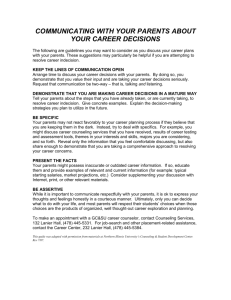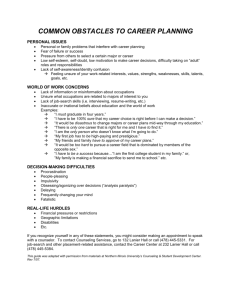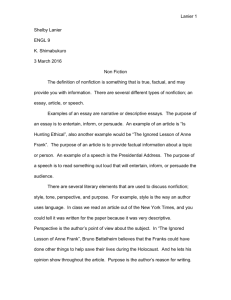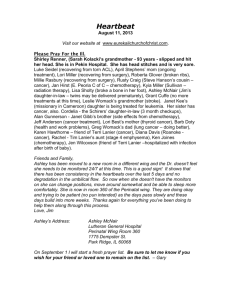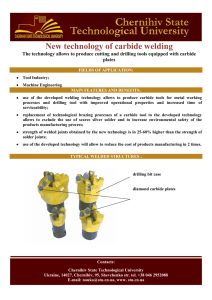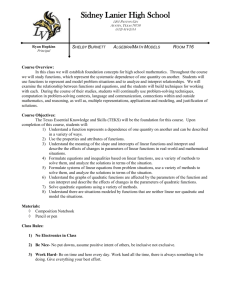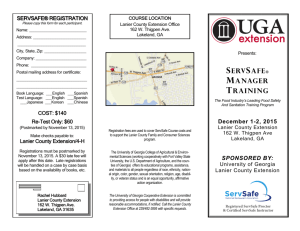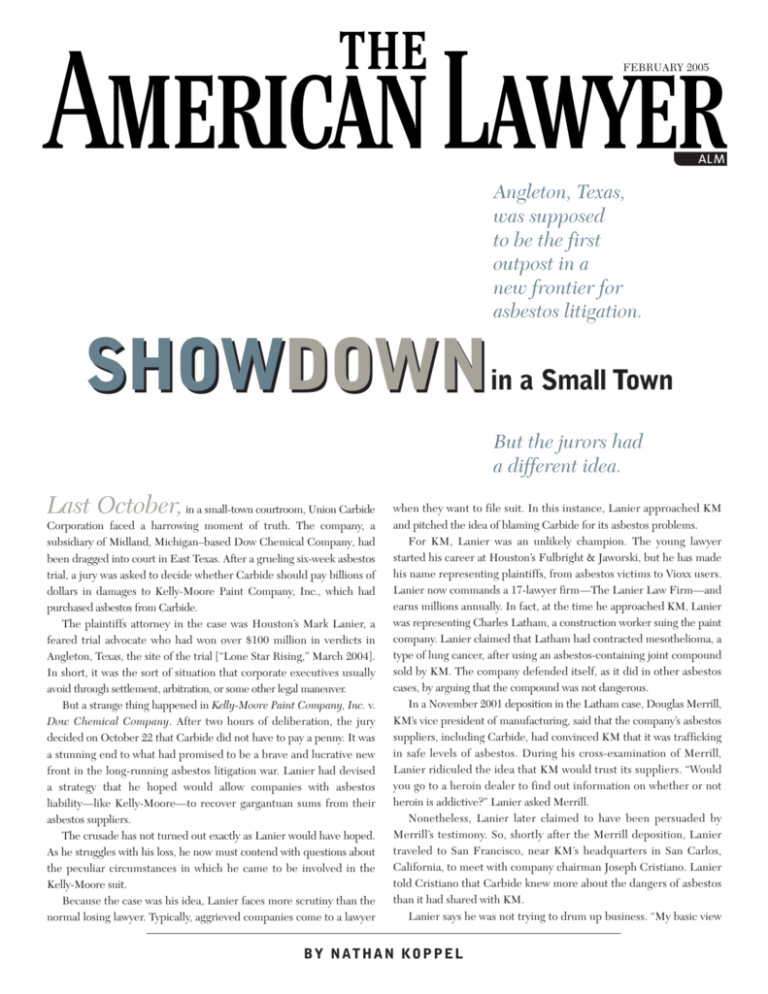
FEBRUARY 2005
Angleton, Texas,
was supposed
to be the first
outpost in a
new frontier for
asbestos litigation.
SHOWDOWN
in a Small Town
But the jurors had
a different idea.
Last October, in a small-town courtroom, Union Carbide
Corporation faced a harrowing moment of truth. The company, a
subsidiary of Midland, Michigan–based Dow Chemical Company, had
been dragged into court in East Texas. After a grueling six-week asbestos
trial, a jury was asked to decide whether Carbide should pay billions of
dollars in damages to Kelly-Moore Paint Company, Inc., which had
purchased asbestos from Carbide.
The plaintiffs attorney in the case was Houston’s Mark Lanier, a
feared trial advocate who had won over $100 million in verdicts in
Angleton, Texas, the site of the trial [“Lone Star Rising,” March 2004].
In short, it was the sort of situation that corporate executives usually
avoid through settlement, arbitration, or some other legal maneuver.
But a strange thing happened in Kelly-Moore Paint Company, Inc. v.
Dow Chemical Company. After two hours of deliberation, the jury
decided on October 22 that Carbide did not have to pay a penny. It was
a stunning end to what had promised to be a brave and lucrative new
front in the long-running asbestos litigation war. Lanier had devised
a strategy that he hoped would allow companies with asbestos
liability—like Kelly-Moore—to recover gargantuan sums from their
asbestos suppliers.
The crusade has not turned out exactly as Lanier would have hoped.
As he struggles with his loss, he now must contend with questions about
the peculiar circumstances in which he came to be involved in the
Kelly-Moore suit.
Because the case was his idea, Lanier faces more scrutiny than the
normal losing lawyer. Typically, aggrieved companies come to a lawyer
when they want to file suit. In this instance, Lanier approached KM
and pitched the idea of blaming Carbide for its asbestos problems.
For KM, Lanier was an unlikely champion. The young lawyer
started his career at Houston’s Fulbright & Jaworski, but he has made
his name representing plaintiffs, from asbestos victims to Vioxx users.
Lanier now commands a 17-lawyer firm—The Lanier Law Firm—and
earns millions annually. In fact, at the time he approached KM, Lanier
was representing Charles Latham, a construction worker suing the paint
company. Lanier claimed that Latham had contracted mesothelioma, a
type of lung cancer, after using an asbestos-containing joint compound
sold by KM. The company defended itself, as it did in other asbestos
cases, by arguing that the compound was not dangerous.
In a November 2001 deposition in the Latham case, Douglas Merrill,
KM’s vice president of manufacturing, said that the company’s asbestos
suppliers, including Carbide, had convinced KM that it was trafficking
in safe levels of asbestos. During his cross-examination of Merrill,
Lanier ridiculed the idea that KM would trust its suppliers. “Would
you go to a heroin dealer to find out information on whether or not
heroin is addictive?” Lanier asked Merrill.
Nonetheless, Lanier later claimed to have been persuaded by
Merrill’s testimony. So, shortly after the Merrill deposition, Lanier
traveled to San Francisco, near KM’s headquarters in San Carlos,
California, to meet with company chairman Joseph Cristiano. Lanier
told Cristiano that Carbide knew more about the dangers of asbestos
than it had shared with KM.
Lanier says he was not trying to drum up business. “My basic view
B Y N AT H A N KO P P E L
MICHAEL J.N. BOWLES
DEFENDING UNION CARBIDE, ORRICK’S PETER BICKS WAS “NOT FLASHY,” BUT EFFECTIVE NONETHELESS, SAYS ONE JUROR.
|
was, Here [is the information],” Lanier says
of his meeting with Cristiano. “I said, ‘There
are a number of lawyers who can pursue this
for you. I can give you a list of names. If you
choose not to do it, that’s fine, but you need
to know about it.’ ” Cristiano later testified in
a deposition in the Carbide suit that he was
dubious of Lanier’s motives when they first
met. “In my book, [Lanier] was the enemy,”
Cristiano said in the deposition, “and now the
enemy was coming to us with information
that told us that we’d been deceived.”
By early 2002 KM had set aside its doubts
about Lanier and hired him to sue Carbide.
Before the former adversaries could join
hands, though, KM had to settle Lanier’s
pending cases against the company, including
Latham’s. Lanier says that he had more than a
dozen cases pending against KM and that
each settled for a six-figure sum.
After navigating those potential conflicts,
KM filed suit against Carbide in May 2002 in
Angleton. Lanier chose that venue, a
blue-collar town about 30 miles from
Houston, in part because of its pro-plaintiff
reputation. In 1998 the attorney won a $115
million asbestos verdict there against The
Carborundum Company. The Kelly-Moore
case promised even larger rewards. KM
sought $1.4 billion in actual damages and
more than $4 billion in punitive damages.
The suit would be watched closely—asbestos
attorneys from across the country attended
the trial—because it represented a new,
potentially lucrative avenue of recovery
for asbestos vendors.
For Kelly-Moore, the suit represented an
abrupt about-face. For 25 years it had
proclaimed that its joint-compound products
were safe. But now it was openly recognizing
the dangers. The genesis of the transformation
was remarkable. A 2,000-employee company,
with more than 150 stores, KM had purportedly achieved its eureka moment thanks to
the work of a Houston plaintiffs lawyer—
despite the fact that countless doctors and
media outlets had written about asbestos’s
dangers since the sixties. Even before the
trial, Lanier recognized that the suit was a
reach and that jurors might be hard-pressed
to work up sympathy for a longtime asbestos
defendant-turned-crusader.
The suit was not only a stretch, but a
financially risky one at that. The paint
The American Lawyer • February 2005
company currently faces thousands of
personal injury asbestos suits. It has already
paid $240 million in damages, and it asserted
in the Carbide trial that it would have to pay
$1.37 billion to resolve future asbestos claims.
If KM recovered billions from Carbide, it
would provide a nice buffer against future
personal injury suits. But if the company lost,
it would have to face the plaintiffs bar with its
hands partially tied. As asbestos plaintiffs
lawyer Mark Iola of Dallas explains: “This
[Carbide suit] has taken away the ability of
Kelly-Moore to tell juries that Chrysotile
[asbestos, which was the sort used in KM
products] doesn’t cause mesothelioma. . . . This
has made [cases] against Kelly-Moore easier.”
Why did Kelly-Moore take the risk? The
company declined comment. But Lanier
concedes that mounting asbestos losses
forced KM to at least try to seek cover. “This
[Carbide suit] was their best chance to stay
alive,” he says, although he declined to say
whether KM will file for bankruptcy.
Still, the question remains: Why would
Lanier, who can pick and choose his cases,
get involved in a far-fetched suit, let alone
serve as the catalyst for it? Lanier has risked
professional scorn in doing so. Even before
trial, other asbestos plaintiffs lawyers said,
proudly, that they would not have touched
the Carbide case. “We represent sick people,
and that’s all,” says Oakland asbestos lawyer
Steven Kazan. “Kelly-Moore v. Carbide may
not be Hitler versus Stalin,” he says. “Maybe
it is closer to Idi Amin versus Stalin. But
still, these are not the people that I want
to be seen with.”
One obvious explanation is money: By
convincing KM to hire him, Lanier could
induce KM to settle all of his personal injury
suits against the company. Lanier denies that
this was his strategy. He says that he never
had trouble winning cases against KM in
court. He further points out that he took the
Carbide case on contingency and personally
fronted the first $1 million in expenses. If he
had filed the suit to strike it rich, Lanier says,
“I [would be] a stupid businessman.”
On paper, Carbide may have had the
upper hand in the case. But the company still
approached the Angleton trial with trepidation.
“This was a $6 billion case in Lanier’s
backyard . . . [and] Lanier is very feared,”
says Carbide’s lead lawyer, Peter Bicks, a
|
partner in the New York office of Orrick,
Herrington & Sutcliffe.
T
HE TRIAL BEGAN ON
Monday, September 13.
Lanier tried the case with
his usual gusto. In court,
he typically adopts a
manner of plainspoken
outrage as he attempts to
beatify his client and demonize the
defendant. It’s a style that is more suited to
personal injury trials than corporate
slugfests, yet Lanier made no attempt to tone
down his rhetoric. In his opening he painted
a loving and exaggerated portrait of
Kelly-Moore as a mom-and-pop outfit,
started by William Moore after he returned
from World War II. “He was a lieutenant [in
the Navy]. Came back a war hero,” Lanier
said. In contrast, Lanier portrayed Carbide
as megalithic and craven. He argued that in
the sixties, Carbide knew about the dangers
of asbestos, yet decided to “make hay while
the sun shines.” Lanier even took aim at his
opposing counsel, seemingly never missing
an opportunity to point out that Peter Bicks
was from New York.
Bicks and his cocounsel, Scott Lassetter,
the managing partner of Weil, Gotshal &
Manges’s Houston office, adopted a more
subdued approach. “[Lanier’s opening] would
make a good episode of Geraldo,” Lassetter
said in his opening. “But it doesn’t have
anything to do with what happened between
Union Carbide and Kelly-Moore.” Lassetter
argued that Carbide had been candid about
the dangers of asbestos and that KM, in
any event, was sophisticated enough to find
out about the hazards on its own. “Mr. Moore
was a chemical engineer,” said Lassetter.
“He employed highly skilled chemists
to work for him.”
Over the course of the six-week trial,
Lanier did his best to place Carbide in a
negative light. He introduced incendiary
evidence, portraying Carbide as callous and
manipulative. But he was far less successful at
portraying his client as a hapless victim. KM
was not able to offer any direct evidence to
indicate that the company had relied on
Carbide’s representations about asbestos.
Company founder William Moore was too
|
The American Lawyer • February 2005
sick to testify (he died shortly after the trial
ended). His wife, Desiree Moore, did get on
the witness stand, but the jury paid little
attention to her. “She was just a grandmother
who couldn’t remember anything,” says
Gregory Wilson, the jury foreman. Carbide,
meanwhile, did a good job of challenging the
notion that it was KM’s sole source of
information about asbestos by asserting that it
supplied only 8 percent of KM’s supply of
asbestos. (The 8 percent figure would later
weigh heavily in the jury’s decision.)
Although he had a difficult case, Lanier
impressed most of the jurors. Even when the
other attorneys were talking, says Wilson,
Lanier would flash incredulous looks or
scribble on a notepad so furiously that the
jury could not help but stay riveted on him.
“He was very entertaining,” says Wilson. Adds
another juror, Michael Lassman: “He did
the best job, hands down. He instantly
established a rapport with the jury.” Yet one
juror, Glenn Rogers, thought Lanier was too
theatrical. In questioning Carbide’s experts,
Rogers says, Lanier would affect an air of
exaggerated doubt: “You’re not really a
doctor, are you?” says Rogers, mimicking
Lanier. “It got to the point where I’d wince
every time [Lanier] opened his mouth.”
Carbide’s lawyers drew mixed reviews. In
the third week of trial, Lassetter bungled a
cross-examination of KM’s damages expert,
which destroyed Lassetter’s credibility with
the jury. “Lassetter just bombed,” says juror
Art DeKenipp. Bicks fared much better. “He
was not dynamic, not flashy,” says Wilson.
“But he was extremely effective.” Jurors gave
Bicks especially high marks for his closing,
where Bicks hammered KM’s inconsistency
|
in asserting, in other asbestos cases, that
its products were not dangerous. “You
can’t tell juries two different, opposite
things,” Bicks asserted. “You can’t be believed
if you do that.”
I
N THE END, THE VERDICT WAS
more about substance than attorney
style. The jurors decided 11 to 1
that Carbide did not defraud KM.
To find fraud, jurors needed to
conclude that Carbide misrepresented the dangers of asbestos and
that KM relied on those misrepresentations.
According to interviews with six jurors, the
jury overwhelmingly believed that Carbide
committed misrepresentation. Yet, all but one
juror believed that KM did not prove reliance.
There was so much information in the news
media about the dangers of asbestos, that it
was implausible to think that KM relied solely
on Carbide to educate it about asbestos, says
juror Rogers: “KM was not in a box.” Another
juror, speaking on background, questioned
whether KM would truly rely on such a minor
supplier: “Carbide sold only 8 percent of the
total asbestos that Kelly-Moore bought,”
she says. “But [KM] was holding Carbide
responsible for all of it.”
Lanier still has an opportunity to redeem
his loss. He filed a motion for new trial, which
was denied in early January. But he has also
filed a similar suit in Los Angeles on behalf of
another asbestos vendor, Hamilton Materials,
Inc. The maker of construction products
claims that Carbide, its asbestos supplier, hid
the dangers of asbestos from it. Like KM,
Hamilton is trying to force Carbide to pay for
all of Hamilton’s future asbestos damages.
Bicks is defending Carbide, setting up a
possible rematch between the Angleton lawyers.
Lanier’s confidence should be shaken
heading into Round Two. Whatever favorable
evidence that he uncovers in the Hamilton
case, the attorney has learned how hard it is to
get a jury to rally to the side of an asbestos
vendor. The jurors in Kelly-Moore, after all,
believed that Carbide was a bad actor—
“Union Carbide was no rose, more like the
thorn of a rose,” says juror Cindy Romeo—but
they chalked up the company’s wrongdoing
to the rough-and-tumble mores of the
business world. “A lot of us felt that there
were misrepresentations [by Carbide],” says
juror Lassman. “But the feeling was that is just
business. . . . [Carbide] was just doing that to
sell more asbestos.”
Bicks believes that the result in Angleton
should chill future vendor-versus-supplier
litigation. “The [Kelly-Moore] case was
brought in what is viewed to be one of the
most plaintiff-friendly jurisdictions in the
country by a lawyer whose reputation was that
he was invincible in that jurisdiction,” says
Bicks. “If this lawyer in this venue couldn’t
prevail, it suggests it is a tough case.”
Lanier, though, is not deterred. “The
first [personal injury] asbestos case was
lost by the plaintiffs,” he points out. “I just
believe in these cases. I’m not backing
off. ”At least no one can claim that Lanier
is trying to bolster his reputation by
picking easy cases to try.
E-mail: nkoppel@amlaw.com.
This article is reprinted with permission from the February 2005 edition of the THE AMERICAN LAWYER. © 2005 ALM Properties, Inc. All rights reserved. Further
duplication without permission is prohibited. For information, contact American Lawyer Media, Reprint Department at 800-888-8300 x6111. #001-02-05-0003

